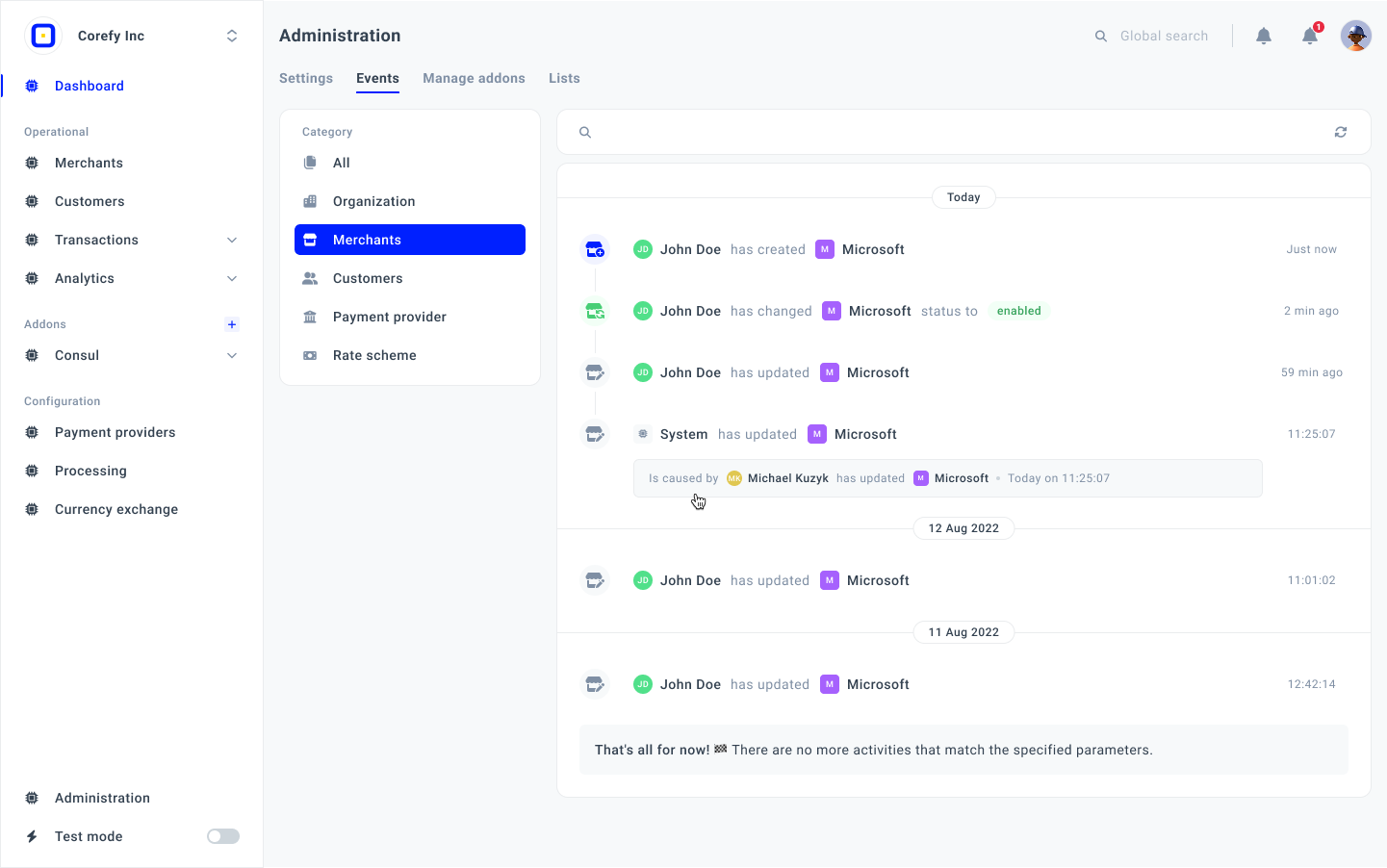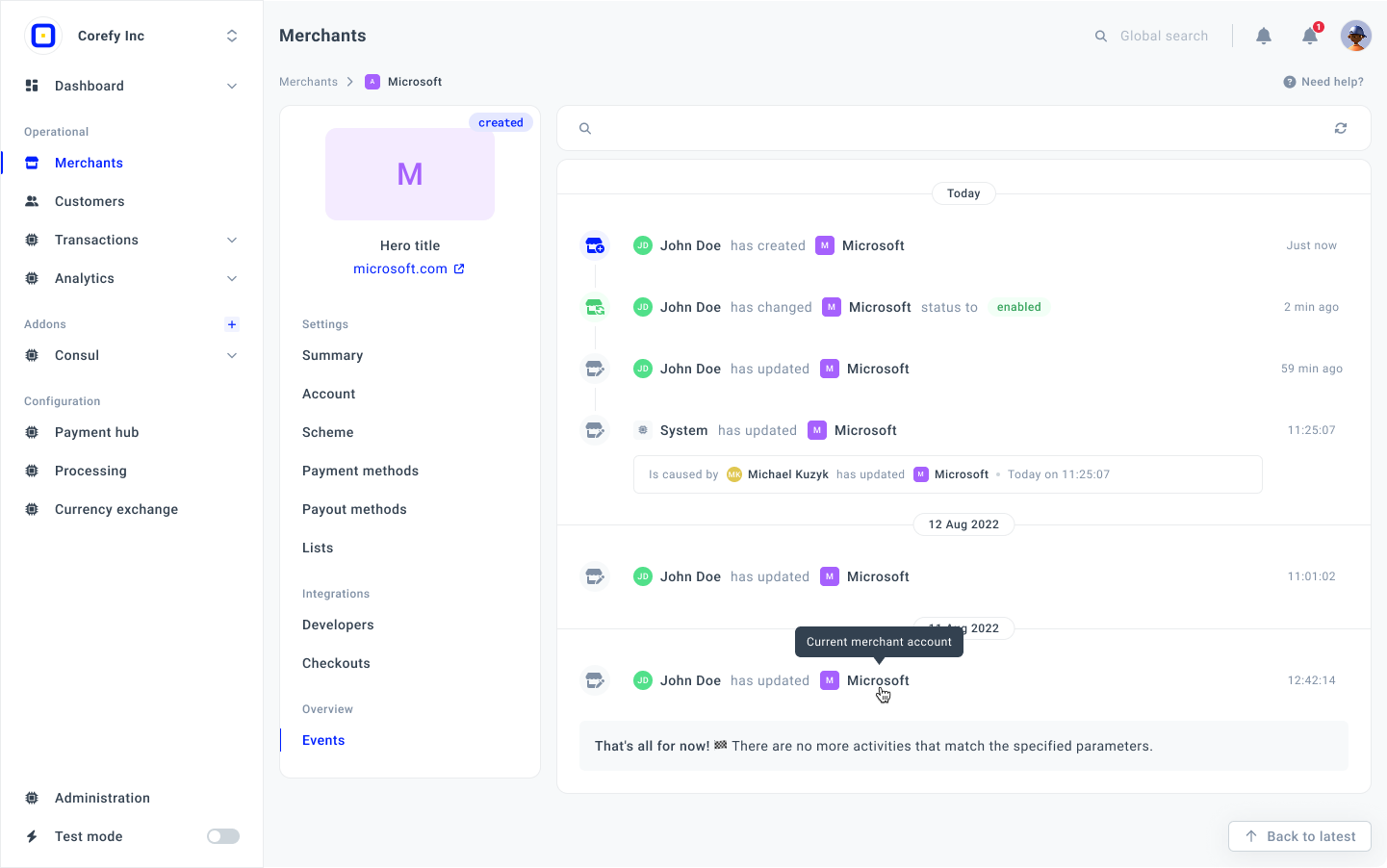Audit log
What is an Audit log?
The Audit log is an umbrella term covering all the activities and changes made to particular entities in our system. It presupposes the ability to have a detailed record of all the Events and actions that occur so that it should be easy to track and analyse them.
The Events include all the actions that are made and can be viewed. In this respect, we differentiate several types of Events depending on their location in our system and the function they perform.
The primary purpose of such a functionality is to ensure the clear traceability of all the operations, paying thorough attention to security and process monitoring.
1. Track the activity on Dashboard
Who and how can track the Events?
Actors
Actors are the process participants that can perform any actions in our system. They can have a different influence on the potential outcome.
| Actor | Description |
| User | The Actor performs the actions and activities or initiates status changes manually. |
| System | The Actor is responsible for the automatic actions resulting from user activities, etc. |
| API | The Actor covers the activities related to capturing API requests, returning payment statuses, etc. |
| Admin | The Actor covers technical support activities such as investigating issues, managing permissions, etc. |
→ Events in the Administration
- Navigate to the Administration and switch to the Events tab.
- Choose the category where you want to check the activity and click it on the navigation bar on the left side of the page. The system allocates all the Events based on the chosen category via the filter capabilities.
- The data reproduced in the activity block are as follows: Actor, Action, Target entity, Associated entity, and Timestamp.
- The data is provided from the newest to the oldest. The system shows the precise time if the actions were performed later than 1 hour ago.

→ Events of the specific entity
- Navigate to a specific entity and click it to review the details.
- Choose the Events tab of the entity where you want to check the activity.
- Track the related information in the activity block.

→ Events in the Account settings
- Click the user icon in the top right corner of the page.
- Go to the Events tab and track all the activities you (as a particular user) perform in all the Organisations.
Icons & Colour coding
| Icon | Meaning |
| {icon} with a plus circle sign | The icon refers to creating a new entity in our system, e.g. The user creates a Merchant account. |
| {icon} with a rotate sign | The icon refers to the process when the entity status is changed. |
| {icon} with a pen sign> | The icon refers to the process of updating the entity. |
| Colour | Meaning |
| blue | The {icon} with a plus circle sign in a blue colour covers the process when the entity is added or created. |
| green | The {icon} with a rotate sign in a green colour refers to the procedure when the entity status is changed to Enabled. |
| red | The {icon} with a rotate sign in a green colour refers to the process when the entity status is changed to Disabled. |
| grey |
|
2. View the details of each Event
- Click the particular Event you want to check the details about.
- The system should initiate opening a drawer with the corresponding details.
- The Event details may vary depending on which entity is chosen to track the Event and the Actor that initiated it.

3. Events overview
The following tables include the Events you can track within our system based on your needs and related entities.
Payment Request
| Event | Description |
| payment_request.created | The Payment Request was successfully created in the system. |
| payment_request.failed | The Payment Request failed due to termination, reached retry limit or expiration. |
| payment_request.expired | The Payment Request has expired and is no longer valid. |
| payment_request.attempted | The Payment attempt was made. |
| payment_request.pending | The system marks that at least one Payment Commit has a successful financial transaction. |
| payment_request.paid | The Payment Request was fully paid by the involved party. |
| payment_request.partially_paid | The Payment Request was partially paid by the involved party. |
| payment_request.returned | The Payment Request funds have been fully returned. |
| payment_request.verified | The Payment Request has been verified. |
| payment_request.cancelled | The Payment Request was cancelled due to various reasons. |
| payment_request.processed _amount_changed |
The amount processed for the Payment Request has been modified. |
| payment_request.finalized | The Payment Request was successfully finalized. |
Merchant account
| Event | Description |
| merchant_account. updated |
The Merchant account was successfully updated. |
Customer
| Event | Description |
| customer.created | A new Customer was created in the system. |
| customer.updated | The |
| customer.payment _token.created |
The Customer’s payment token was created in the system. |
| customer.payment _token.deleted |
The Customer’s payment token was deleted. |
Payment account
| Event | Description |
| payment_account.created | The Payment account was created in the system. |
| payment_account.updated | The Payment account was successfully updated. |
| payment_account.expired | The Payment account has expired. |
Updated about 1 month ago
